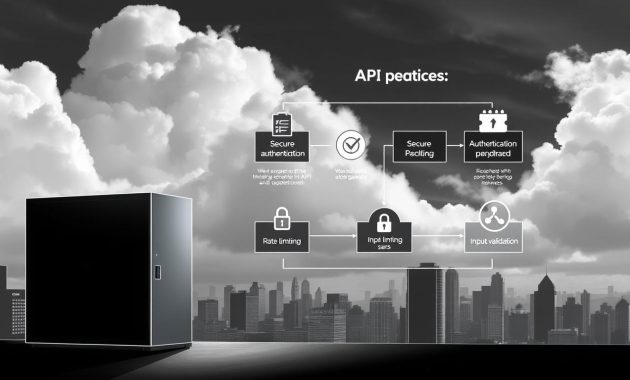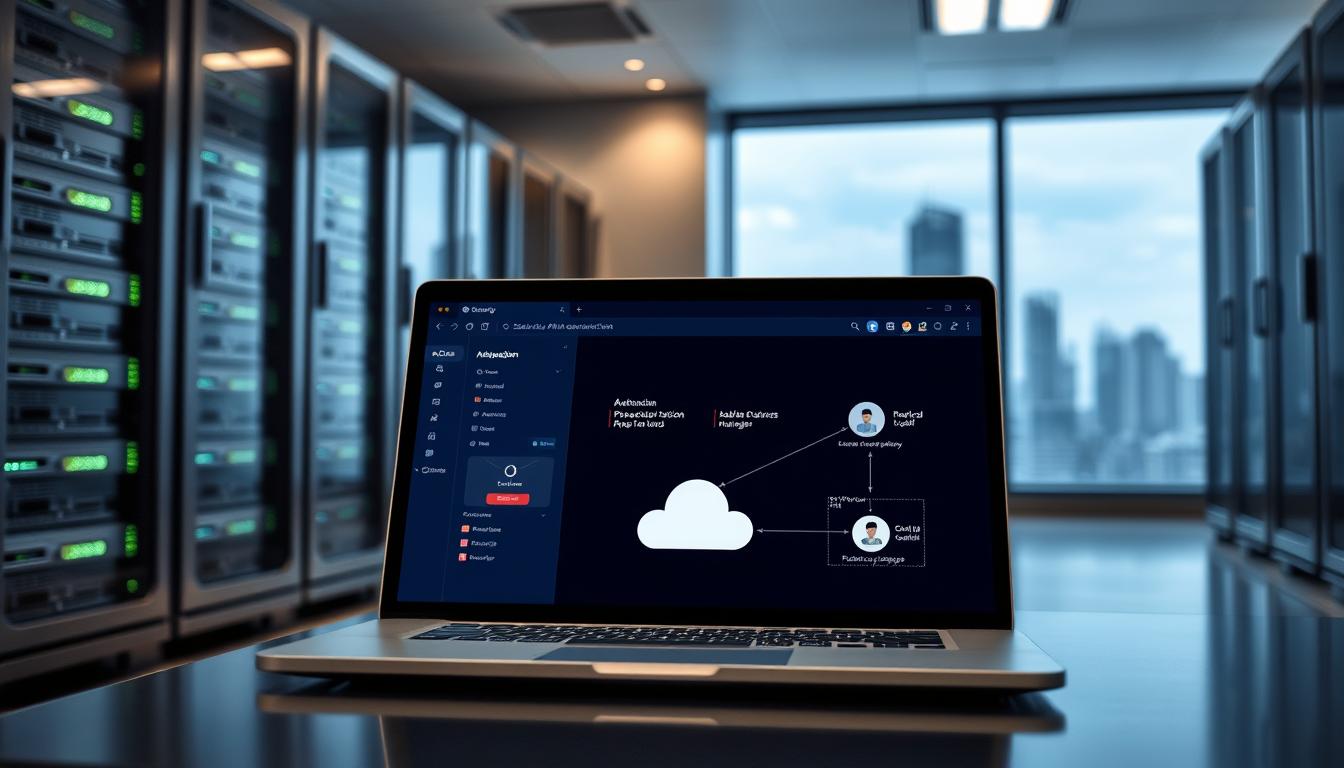In the transition to cloud-based operations, the imperative of API security cannot be overstated. The safeguarding of APIs against unauthorized access and the protection of sensitive data are paramount. It is imperative to fortify cloud server security to avert data breaches.
The implementation of stringent security protocols is critical for API protection. It is essential to focus on the management of API security, cloud server security, and the assurance of API integrity. Such measures are vital in mitigating security risks and safeguarding your enterprise against potential threats.
Understanding API Security Risks in Cloud Servers
In the realm of cloud server environments, the significance of API security cannot be overstated. The potential risks stemming from inadequate security measures are profound, encompassing data loss, financial repercussions, and reputational damage. Cloud server vulnerabilities, such as deficient authentication mechanisms and insufficient encryption, render APIs susceptible to attacks.
The role of compliance requirements in safeguarding APIs within cloud servers is paramount. Regulatory mandates, including GDPR and HIPAA, necessitate the implementation of stringent security protocols to protect sensitive data. Non-compliance with these regulations can incur substantial fines and irreparable damage to one’s reputation.
To counteract API security risks, it is imperative to identify and address common vulnerabilities. These include inadequate authentication mechanisms, insufficient encryption, and poor access controls. By comprehending these vulnerabilities and implementing corrective measures, the risk of a security breach can be significantly diminished, thereby ensuring the integrity of APIs.
Best Practices for Securing APIs on Cloud Servers
To safeguard your APIs on cloud servers, it is imperative to adopt best practices that counteract prevalent threats. Initiating with authentication protocols, such as OAuth and JWT, is vital. These mechanisms are indispensable for verifying that only legitimate users gain access to your APIs.
Encryption stands as a cornerstone of API security. Employing SSL/TLS and HTTPS ensures the confidentiality and integrity of data during transmission, thereby thwarting unauthorized access. Furthermore, implementing rate limiting and throttling measures is essential to mitigate API abuse and denial-of-service attacks.
Consideration of the following API security best practices is paramount:
- Implementing robust authentication mechanisms
- Utilizing data encryption techniques, such as SSL/TLS and HTTPS
- Enabling rate limiting and throttling to prevent API abuse
Adherence to these best practices and continuous updates on the latest API security measures are crucial. They enable the protection of your APIs against common threats, thereby ensuring the security and integrity of your data.

Tools and Technologies for API Security
In the quest to fortify API security, it is imperative to delve into the array of tools and technologies at your disposal. API security tools are pivotal in safeguarding your APIs against potential threats. API gateways serve as the initial entry point for APIs, offering a security and control layer. Furthermore, Security Information and Event Management (SIEM) systems monitor and dissect security-related data, aiding in the detection of potential threats.
Several technologies stand out in the realm of API protection. These include:
- API gateways, which provide a secure entry point for APIs
- SIEM systems, which monitor and analyze security-related data
- Web Application Firewalls (WAF), which protect against common web attacks
- Distributed Denial-of-Service (DDoS) protection, which ensures API availability
By integrating these API security tools and technologies, you can adeptly manage API security on cloud servers. API gateways and SIEM systems collaborate to offer a holistic security solution. Concurrently, WAF and DDoS protection services shield against prevalent web attacks and guarantee API uptime. By harnessing these tools and technologies, you can significantly bolster the security of your APIs and safeguard your cloud server environment.
Implementing a Secure API Development Lifecycle
As APIs are developed, integrating security into each stage is paramount. This methodology ensures APIs are conceived and constructed with security as a foundational element, thereby minimizing vulnerability and breach risks. Secure API development encompasses several critical practices, including code review, CI/CD security, and monitoring and logging.
Code review necessitates thoroughness. It serves to uncover and rectify vulnerabilities at an early developmental stage, averting their escalation into significant issues. Moreover, securing Continuous Integration and Deployment (CI/CD) pipelines is imperative to thwart unauthorized access and modifications.

- Implement continuous monitoring to detect and respond to security incidents
- Use logging practices to track and analyze API activity
- Integrate CI/CD security into your development pipeline to ensure secure deployment
By embedding these practices into your API development lifecycle, you can guarantee that your APIs are not only secure but also dependable and compliant with regulatory standards. It is imperative to remember that a secure API development lifecycle is fundamental for safeguarding user data and averting security breaches.
Responding to API Security Incidents
In the realm of API security, it is paramount to acknowledge that, despite rigorous precautions, security incidents can still manifest. The imperative of having a well-structured API security incident response framework is thus underscored. This necessitates the development of an incident planning strategy, delineating protocols for breach identification, containment, and mitigation.
Forensic analysis emerges as a pivotal component within this framework, facilitating an elucidation of the breach’s extent and nature. Through such analysis, vulnerabilities are unearthed, enabling proactive measures to forestall future breaches. Concurrently, the deployment of communication strategies is indispensable, facilitating the dissemination of incident information to stakeholders and the broader public, coupled with the elucidation of corrective actions undertaken.
- Conducting a thorough forensic analysis to determine the cause and scope of the breach
- Implementing incident planning procedures to contain and mitigate the incident
- Developing and executing effective communication strategies to inform stakeholders and the public
- Reviewing and revising your API security incident response plan to prevent similar incidents in the future
Adherence to these protocols, coupled with a comprehensive API security incident response plan, enables the mitigation of incident repercussions, thereby preserving the integrity of your APIs.
Future Trends in API Security for Cloud Environments
The increasing reliance on cloud-based APIs is driving a rapid evolution in API security. New trends and technologies are redefining the protection of API infrastructure on cloud servers. This transformation is crucial for the future of cloud-based API environments.
AI and Machine Learning Solutions
Artificial Intelligence (AI) and Machine Learning (ML) are set to revolutionize API security. These advanced analytics tools will enable real-time threat detection and response. They will identify anomalies and automate security processes, enhancing the resilience and adaptability of cloud-based API environments.
Zero Trust Architecture
The Zero Trust Architecture is gaining traction in API security. This model views all users, devices, and applications as potential threats, necessitating continuous verification. By adopting Zero Trust, organizations can significantly reduce API vulnerabilities and unauthorized access, ensuring robust protection for their cloud-based API infrastructure.
Increasing Importance of API Governance
APIs are becoming increasingly vital to business operations, highlighting the growing importance of API governance. Establishing clear standards, policies, and oversight mechanisms is essential for managing API security, lifecycle, and compliance. Organizations prioritizing API governance will be better positioned to secure their APIs on cloud servers and maintain the integrity of their API ecosystem.
By embracing these future trends, organizations can stay ahead of emerging API security threats. Leveraging AI, adopting Zero Trust Architecture, and implementing robust API governance are essential for navigating the evolving landscape of API security. These strategies will be critical in the years to come.
